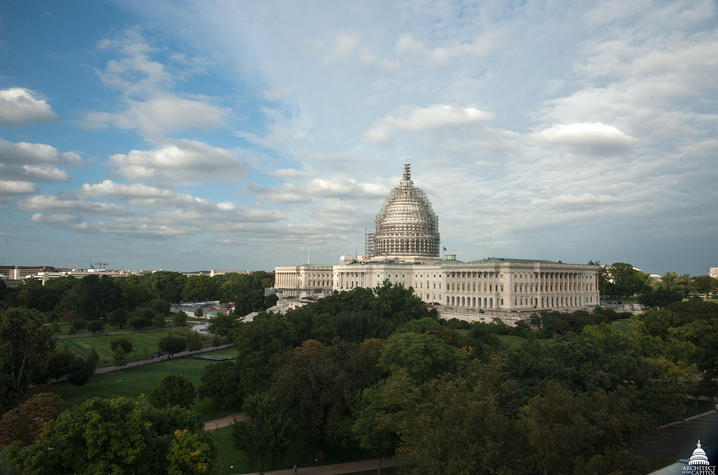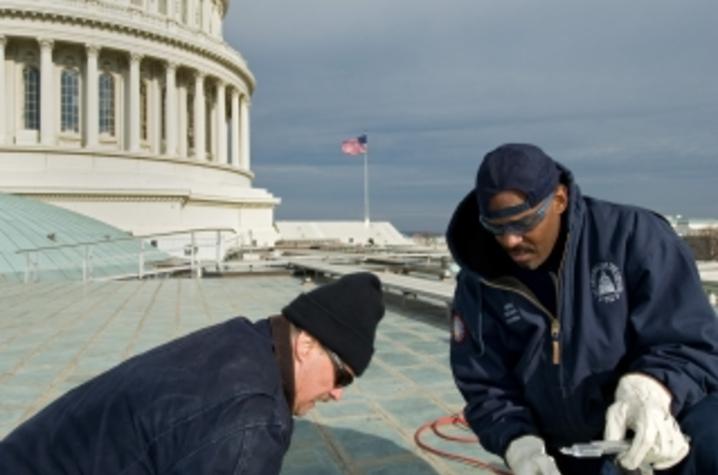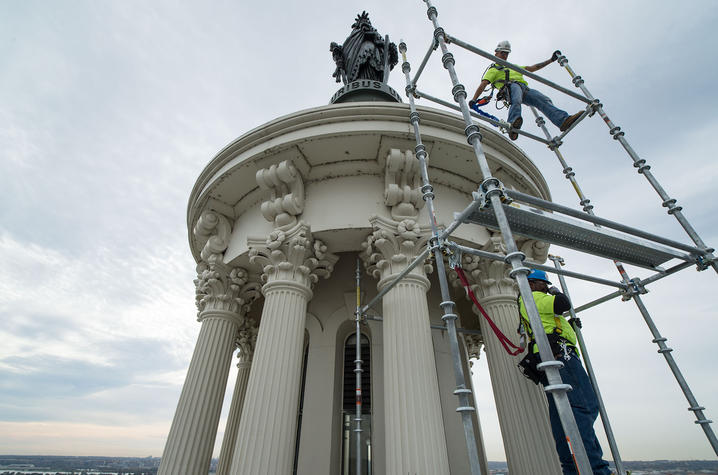UK Grad Helps Return Nation's Capitol Building to Original Grandeur
Video courtesy of Architect of the Capitol.
LEXINGTON, Ky. (March 24, 2016) — Just a few drops.
In 1999, a few drops of water found their way to the rotunda floor from the upper levels of the U.S. Capitol Building.
Those drops would set in motion what is now known as the U.S. Capitol Dome Restoration project.
And the success of this multi-year, nearly $60 million dollar project will not go unnoticed, as the building will be on display to the world when the nation's 45th president is sworn into office on the building's steps in front of more than a million spectators and millions more watching the ceremony in live TV broadcasts around the globe Jan. 20, 2017.
Helping to ensure the dome returns to its original splendor by that fated date is Project Manager and Capitol Jurisdiction Project Executive for the Architect of the Capitol Eugene Poole Jr., a 1985 architecture graduate of the University of Kentucky and native of Hopkinsville, Kentucky.
"It is an awesome honor to serve as an ambassador for the United States Capitol building and a tremendous responsibility," Poole said. "In 1985 when I was in college at UK, if anyone were to have told me that I would, (in the future), become the project manager for the iconic Dome Restoration project and be the jurisdiction executive for the U.S. Capitol building, I would have laughed and said, 'No way!'; but, here I am, and it’s simply awesome!"
Since 1999, several years of study and numerous pilot projects were initiated to extensively assess the overall condition of both the interior and exterior dome shells. The project design required many trade professionals and industries coming together to fully assess, vet and define the project scope requirements before initiating the design protocol and subsequently drafting the statement of work and execution. In 2008, Poole was assigned as project manager with the responsibility to manage various phases of the U.S. Capitol dome project, including the interim painting phase and the two-year Dome Restoration Design Revalidation. In 2012, he managed procurement actions for the issuance and award of the complete restoration of the U.S. Capitol dome.
"Our main goal was to ensure that we performed the work in a responsible manner that is consistent with industry standards while also protecting the existing historical fabric, performing great historic preservation, minimizing any impact to the daily business of Congress, and keeping the project safe for all workers and consultants," Poole said.
The execution of the Dome Restoration project is being accomplished in three phases:
· Exterior: Repair of existing iron exterior cracks by metal stitching, removal of 150 years of built-up paint to reveal intricate details, preparation of iron substrate, and repainting the exterior dome shell with a high performance epoxy coating system.
· Interior: Upgrading of electrical, mechanical, fire alarm, communications and lighting systems in the interstitial space of the dome.
· Rotunda: Removal of 150 years of built-up paint from the inner dome coffers to reveal the intricate and delicate details of the 1850s iron work that expresses the masterful levels of artistry during that era.
The project also calls for the repair of iron work, upgrading mechanical and ventilation systems, and replacing the entire rotunda lighting system with energy efficient lighting. For information on the current phase of the project, visit www.aoc.gov/dome/project-updates. To see photos of the restoration process, the dome prior to restoration and other restorations in the building's history, visit www.aoc.gov/dome/images.
As the jurisdiction executive and project manager for the Architect of the Capitol leading the building's central project, Poole's days are hectic. He reviews construction reports; coordinates any issues with task leaders; reviews contactor submittals and provides guidance recommendations; reviews requests for information; reviews product data and samples; performs routine site inspections and observations; reviews contractor payment applications; executes and signs modifications for potential change orders; coordinates with onsite safety personnel; develops weekly and monthly reports; briefs upper level management on current project status; reviews project schedules and payment applications, as well as a myriad of other daily tasks to keep the project on track, safe and productive and maintain construction quality requirements.
Poole's studies and work experience made him the perfect fit to take on such a monumental restoration. His interest in architecture started early and even shaped his college choice.
"I chose architecture because even as a child, I was interested in the built environment. I was very curious and precocious about how things fit together and at age 12, I knew I wanted to be an architect," Poole said. "I chose the University of Kentucky because of its outstanding accredited program and world class professors, many of whom have made significant strides globally in the architecture profession and overall construction industry. The UK College of Architecture (now UK College of Design) faculty comprises a diverse and mainly eclectic group of industry professionals that both challenge and provoke the thought process while simultaneously stimulating and demanding the best personal performance of each student."
And while he did find time to attend the occasional UK basketball game, Poole, like many other UK architecture students who followed him, spent most of his waking hours designing and constructing models in the studio and working in the wood shop. He also recalls many of the lessons and advice faculty offered him along the way, from scholarship recommendations by then-dean, Anthony Eardley, to encouragement to explore sustainable design by Richard Levine, to lessons in how to navigate the architecture profession and educate the public from Professor Clyde Carpenter, to advice on how to manage projects from a legal perspective from John Russell Groves.
After graduation, Poole's architecture and Air Force ROTC studies at UK propelled him to a valuable military career in the field of design.
"I knew that as an officer, I could immediately assume high levels of responsibility and be exposed to cutting-edge technologies within the industry, experience networking opportunities, and realize worldwide travel which allowed me to see, experience and study different cultures and their approaches to design given their geographic locations," Poole said.
His military service took him throughout the United States and overseas to Guam, Japan, Korea, Saipan, England and Germany and afforded him many opportunities. "As an Air Force officer, (captain), I was an architect during my entire Air Force career and experienced an enormous level of responsibility and accountability as I managed millions of dollars of construction and executed all types of new construction, renovations, upgrades, retro-fits, demolitions, building reassignments, restorations and horizontal construction for the Department of Defense."
While he may have never imagined taking on leadership of the U.S. Capitol Dome Restoration project, Poole is honored to take on such an important project for an icon of U.S. history and government.
"The most rewarding part of my job is the visual actualization of the work being performed and the three dimensional results of those efforts. It is extremely gratifying to design a project, then, watch that project become a reality," he said. "Restoration of this historic building is the pinnacle of my professional career."
And Poole's advice for young architects hoping to achieve the success he has in his career?
"Study, study, study. Success = Preparation + Opportunity. When you strive to do your best, eventually, your hard work will be noticed. To do anything great, preparedness, commitment, passion and your total commitment to a vision principle must be in place. You must have both feet firmly planted and demand nothing less than excellence from yourself in all of your pursuits."
U.S. Capitol Dome
Historical Facts
January 2016
· The U.S. Capitol dome has 36 structural ribs on its outer shell, (cupola). Each rib is set 10 degrees apart to make up 360 degrees.
· The U.S. Capitol dome is made of cast iron and weighs 8,909,200 million pounds.
· The U.S. Capitol dome stands at 288 feet high.
· Abraham Lincoln was the sitting president during construction of the redesigned iron dome of the U.S. Capitol.
· The top of the U.S. Capitol is 209 feet lower than the Washington Monument.
· The custom of flying the flags 24 hours a day over the east and west fronts was begun during World War I.
· Thomas U. Walter designed the U.S. Capitol dome and was the architect for the House and Senate building extensions.
· George Washington himself laid the cornerstone for the Capitol on Sept. 18, 1793, in a Masonic ceremony.
· Congress first met in the U.S. Capitol building on Nov. 17, 1800.
· The U.S. Capitol Building Rotunda is used for inaugurations and distinguished individuals lying in state.
· The iron used to build the U.S. Capitol Dome in 1856 cost approximately $0.07 cents per pound.
· There are no back doors on the U.S. Capitol building; each entrance is called a “front” entrance; there are four main fronts (north, south, east and west).
· The Statue of Freedom was cast in bronze. It was cast in five sections. It is 19 feet 6 inches tall. The Statue of Freedom faces “east” atop the U.S. Capitol building and weighs 15,000 pounds (7 ½ tons).
· The U.S. Capitol was burned by the British in the War of 1812, however, a well-timed storm put out the blaze.
UK is the University for Kentucky. At UK, we are educating more students, treating more patients with complex illnesses and conducting more research and service than at any time in our 150-year history. To read more about the UK story and how you can support continued investment in your university and the Commonwealth, go to: uky.edu/uk4ky. #uk4ky #seeblue
MEDIA CONTACT: Whitney Hale, 859-257-8716; whitney.hale@uky.edu










